Sanmac® 2205 is a machinability-improved version of the duplex (austenitic-ferritic) stainless steel SAF™ 2205. The grade is characterized by:
- Excellent machinability
- High resistance to stress corrosion cracking (SCC) in chloride-bearing environments
- High resistance to stress corrosion cracking (SCC) in environments containing hydrogen sulfide
- High resistance to general corrosion, pitting and crevice corrosion
- High mechanical strength – roughly twice the proof strength of austenitic stainless steels
- High resistance to erosion corrosion and corrosion fatigue
- Physical properties that offer design advantages
- Good weldability
Standards
- UNS: S31803, S32205
- EN Number: 1.4462
- W.Nr.: 1.4462
Product standards
- EN 10088-3, EN 10088-5 (dimensions up to 160 mm), EN 10272, EN 10222-5, ISO 17781
- ASTM A479, ASTM A276,
- NORSOK MDS D47 Rev 3, Rev 4, Rev 5
- Chemical composition and mechanical properties acc. to ASTM A182
Approvals
- Pressure Equipment Directive (2014/68/EU)
- NORSOK M650 Ed. 4, NORSOK M630 Ed. 6, dimensions up to 260 mm
- DNV, dimensions up to 300 mm
- Pre-approval for PMA
Certificate
- Status according to EN 10204/3.1
Chemical composition (nominal)
| C | Si | Mn | P | S | Cr | Ni | Mo | N |
|---|---|---|---|---|---|---|---|---|
| ≤0.030 | ≤1.0 | ≤2.0 | ≤0.030 | ≤0.015 | 22.5 | 5.5 | 3.2 | 0.18 |
Applications
Due to its excellent corrosion properties, Sanmac® 2205 is a highly suitable material for service in environments containing chlorides and hydrogen sulfide. The material is suitable for use in production tubing and flowlines for the extraction of oil and gas from sour wells, in refineries and in process solutions contaminated with chlorides. Sanmac® 2205 is particularly suitable for heat exchangers where chloride-bearing water or brackish water is used as a cooling medium. The steel is also suitable for use in dilute sulfuric acid solutions and for the handling of organic acids, e.g. acetic acid and mixtures.
- The high strength of Sanmac® 2205 makes the material an attractive alternative to the austenitic steels in structures subjected to heavy loads.
- The good mechanical and corrosion properties make Sanmac® 2205 an economical choice in many applications by reducing the life cycle cost of the equipment.
- The good machining properties make Sanmac® 2205 a superior alternative to standard 2205 grades and other duplex grades for applications subjected to all types of machining by extended tool life and possibilities to increase productivity.
Corrosion resistance
General corrosion
In most media, Sanmac® 2205 possesses better resistance to general corrosion than steel of type ASTM 316L and ASTM 317L. Impurities that increase corrosivity are often present in process solutions of acids. If there is a risk of active corrosion, higher-alloyed austenitic stainless steels should be chosen, e.g. Alleima® 2RK65 or Sanicro® 28.
Stress corrosion cracking
The standard austenitic steels of the ASTM 304L and ASTM 316L types are prone to stress corrosion cracking (SCC) in chloride-bearing solutions at temperatures above 60°C (140°F). Duplex stainless steels are far less prone to this type of corrosion. Laboratory tests have shown the good resistance to stress corrosion cracking of Sanmac® 2205. Results from these tests are presented in fig. 5. The diagram indicates the temperature-chloride range within which Sanmac® 2205, the standard steels ASTM 304L and ASTM 316L can be used without a risk of stress corrosion cracking
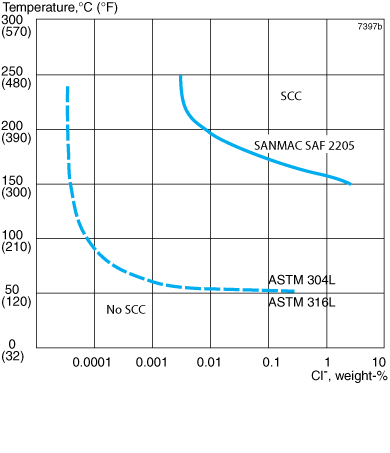 Figure 5. Resistance to stress corrosion cracking, laboratory results.
Figure 5. Resistance to stress corrosion cracking, laboratory results.
In accordance with NACE MR0175/ISO 15156 solution annealed and cold-worked Sanmac® 2205 is acceptable for use at any temperature up to 232°C/450°F in sour environments, if the partial pressure of hydrogen sulfide does not exceed 0.3 psi (0.02 bar) and its hardness is not greater than HRC 36. In the solution annealed and liquid quenched condition Sanmac® 2205 is acceptable for use at any temperature up to 232°C/450°F in sour environments, if the partial pressure of hydrogen sulfide does not exceed 1.5 psi (0.1 bar). According NACE MR0103 solution annealed and rapid quenched Sanmac® 2205, with hardness maximum HRC 28 is acceptable in sour petroleum refining.
Pitting and crevice corrosion
The pitting and crevice corrosion resistance of a steel is determined primarily by its chromium and molybdenum contents, but also by its nitrogen content as well as its slag composition and slag content. A parameter for comparing the resistance of different steels to pitting is the PRE number (Pitting Resistance Equivalent).
CPT ASTM G48 E ASTM 316 15°C
The PRE is defined as, in weight -%:
PRE = % Cr + 3.3 x % Mo +16 x % N
The PRE number for Sanmac® 2205 and some compared materials are given in the following table.
| Alloy | % Cr | % Mo | % N | PRE |
|---|---|---|---|---|
| Sanmac 2205 | 22.5 | 3.2 | 0.18 | >35 |
| Alloy 825 | 21.5 | 3.0 | - | 31 |
| ASTM 317L | 18 | 3.5 | - | 30 |
| ASTM 316L | 17 | 2.2 | - | 24 |
The ranking given by the PRE number has been confirmed in laboratory tests.
Sanmac® 2205 can be used at considerably higher temperatures and chloride contents than ASTM 304 and ASTM 316 without pitting occurring. Sanmac® 2205 is therefore far more serviceable in chloride-bearing environments than standard 304/316 austenitic steels.
Intergranular corrosion
Sanmac® 2205 has a low carbon content and therefore good resistance to intergranular corrosion.
Erosion corrosion
Steels of the ASTM 316 type are attacked by erosion corrosion if exposed to flowing media containing highly abrasive solid particles, e.g. sand, or to media with very high flow velocities. Owing to its combination of high hardness and good corrosion resistance, Sanmac® 2205 displays very good resistance under such conditions.
Corrosion fatigue
Sanmac® 2205 possesses higher strength and better corrosion resistance than 316/316L austenitic stainless steels. Sanmac® 2205 therefore also possesses better fatigue strength under corrosive conditions than such steels.
Forms of supply
Bar
Finishes and dimensions
Bar steel in grade Sanmac® 2205 is stocked in a large number of sizes. The standard size range for stock comprises 20-450 mm. Round bar is supplied in the solution annealed and quenched and peel-turned condition.
Lengths
Bars are delivered in random lengths of 3-7 m, depending on diameter.
| Diameter, mm | Height of arch, mm/m Typical value |
|---|---|
| 20 - 70 | 1 |
| > 70 | 2 |
|
Diameter, mm
|
Tolerances, mm
|
|---|---|
| 20-35 | -0/+0.15 |
| 40-45 | -0/+0.16 |
| 50-70 | -0/+0.19 |
| 75-95 | -0/+1.50 |
| 290-350 | -0/+2.00 |
| 360-450 | -0/+3.00 |
|
Surface conditions
|
Ra, µm
Typical value |
Diameter, mm
|
|---|---|---|
| Peeled and burnished | 1 | 20-285 |
| Peel turned | 2 | >285 - 350 |
| Rough machined | 5 | >350 |
Heat treatment
Sanmac® 2205 stock program bars are delivered in solution annealed and quenched condition.
Solution annealing
Solution annealing at 1020 – 1100°C (1870 – 2010°F) followed by quenching.
Mechanical properties
The following values apply to material in the solution annealed and quenched condition. Bar with sizes larger than 260 mm may have slightly lower values. Contact us for more detailed formation.
At 20°C (68°F)
| Proof strength | Tensile strength | Elong. | Hardness | |
|---|---|---|---|---|
| Rp0.2a) | Rp1.0a) | Ab) | Brinell | |
| MPa | MPa | MPa | % | |
| ≥450 | ≥500 | 660-860 | ≥25 | ≤270 |
| Proof strength | Tensile strength | Elong. | Hardness | |
|---|---|---|---|---|
| Rp0.2a) | Rp1.0a) | Ab) | Brinell | |
| ksi | ksi | ksi | % | |
| ≥65 | ≥73 | 96-125 | ≥25 | ≤270 |
1 MPa = 1 N/mm 2
a) Rp0.2 and Rp1.0 correspond to 0.2% offset and 1.0% offset yield strength respectively.
b) Based on L0 = 5.65√S, where L0 is the original gauge length and S0 the original cross-sectional area.
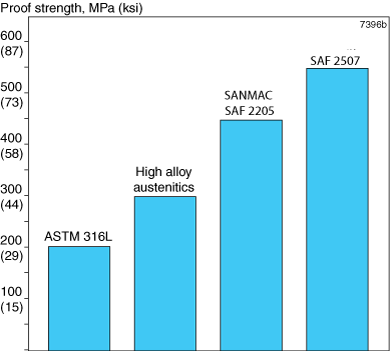
Impact strength
Sanmac® 2205 possesses good impact strength both at room temperature and at low temperatures. Fig. 2 shows typical impact energy values for Sanmac® 2205 bars in different sizes at -50°C (-58°F). The values apply for standard Charpy-V specimens (10 x 10 mm, 0.39 x 0.39 in.) taken in the longitudinal direction of the bar. For dimensions larger than 260 mm (10.2 in.) the impact strength is somewhat lower.
Sanmac® 2205 bar stock program guarantees an impact strength of 45 J (33 ft lb) at -50°C (-58°F) for dimensions up to 260 mm (10.2 in.). Over 260 mm (10.2 in.) values only for information.
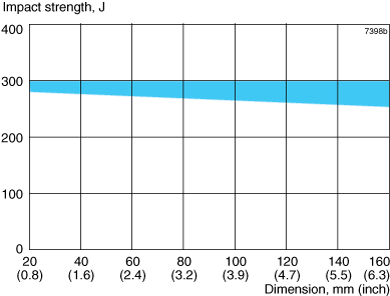 Figure 2. Typical impact strength values for Sanmac 2205 bar at -50°C (-58°F).
Figure 2. Typical impact strength values for Sanmac 2205 bar at -50°C (-58°F).
At high temperatures
If Sanmac® 2205 is exposed for prolonged periods to temperatures exceeding 280 °C (540 °F), the microstructure changes which results in a reduction in impact strength. This effect does not necessarily affect the behavior of the material at the operating temperature. Contact Alleima for advice. For pressure vessel applications, 280°C (540°F) is required as maximum.
| Temp. | Proof Strength | Temp. | Proof Strength |
|---|---|---|---|
| Rp0.2 | Rp0.2 | ||
| °C | MPa | °F | ksi |
| min. | min. | ||
| 100 | 360 | 200 | 52 |
| 150 | 335 | 300 | 49 |
| 200 | 315 | 400 | 46 |
| 250 | 300 | 500 | 44 |
Physical properties
Density: 7.8 g/cm3, 0.28 lb/in3
| Temperature, °C | J/(kg °C) | Temperature, °F | Btu/(lb °F) |
|---|---|---|---|
| 20 | 480 | 68 | 0.11 |
| 100 | 500 | 200 | 0.12 |
| 200 | 530 | 400 | 0.13 |
| 300 | 550 | 600 | 0.13 |
| 400 | 590 | 800 | 0.14 |
Thermal conductivity
| Temperature,°C | 20 | 100 | 200 | 300 | 400 |
|---|---|---|---|---|---|
| W/(m °C) | |||||
| Sanmac® 2205 | 14 | 16 | 17 | 19 | 20 |
| AISI 316L | 14 | 15 | 17 | 18 | 20 |
| Temperature, °F | 68 | 200 | 400 | 600 | 800 |
|---|---|---|---|---|---|
| Btu/(ft h °F) | |||||
| Sanmac® 2205 | 8 | 9 | 10 | 11 | 12 |
| AISI 316L | 8 | 9 | 10 | 10 | 12 |
Thermal expansion, mean values in temperature ranges (X10-6)
| Temperature, °C | 30-100 | 30-200 | 30-300 | 30-400 |
|---|---|---|---|---|
| Per °C | ||||
| Sanmac® 2205 | 13.0 | 13.5 | 14.0 | 14.5 |
| Carbon steel | 12.5 | 13.0 | 13.5 | 14.0 |
| AISI 316L | 16.5 | 17.0 | 17.5 | 18.0 |
| Temperature, °F | 86-200 | 86-400 | 86-600 | 86-800 |
|---|---|---|---|---|
| Per °F | ||||
| Sanmac® 2205 | 7.0 | 7.5 | 7.8 | 8.0 |
| Carbon steel | 6.8 | 7.0 | 7.5 | 7.8 |
| AISI 316L | 9.0 | 9.5 | 9.8 | 10.0 |
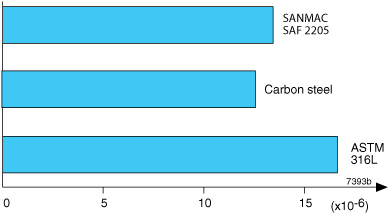 Figure 3. Thermal expansion, per °C (30-100°C.)
Figure 3. Thermal expansion, per °C (30-100°C.)
SANMAC® SAF 2205 has a far lower coefficient of thermal expansion than austenitic stainless steels and can therefore possess certain design advantages.
| Temperature, °C | μΩm | Temperature, °F | μΩin. |
|---|---|---|---|
| 20 | 0.74 | 68 | 29.1 |
| 100 | 0.85 | 200 | 33.1 |
| 200 | 0.96 | 400 | 39.8 |
| 300 | 1.00 | 600 | 43.3 |
| 400 | 1.10 | 800 | 43.3 |
| Temperature, °C | MPa | Temperature, °F | ksi |
|---|---|---|---|
| 20 | 200 | 68 | 29.0 |
| 100 | 194 | 200 | 28.2 |
| 200 | 186 | 400 | 27.0 |
| 300 | 180 | 600 | 26.2 |
Welding
The weldability of SANMAC® 2205 is good. Suitable methods of fusion welding are manual metal-arc welding (MMA/SMAW) and gas-shielded arc welding, with the TIG/GTAW method as first choice.
Since this material is alloyed in such a way to improve its machinability, the amount of surface oxides on the welded beads might be higher compared to that of the standard 2205 steel. This may lead to arc instability during TIG/GTAW welding, especially welding without filer material. However, the welding behavior of this material is the same as for standard 2205 steel when welding with filler material.
For SANMAC® 2205, heat input of 0.5-2.5 kJ/mm and interpass temperature of <150°C (300°F) are recommended. Preheating and post-weld heat treatment are normally not necessary.
Recommended filler metals
TIG/GTAW or MIG/GMAW welding
ISO 14343 S 22 9 3 N L / AWS A5.9 ER2209 (e.g. Exaton 22.8.3.L)
MMA/SMAW welding
ISO 3581 E 22 9 3 N L R / AWS A5.4 E2209-17 (e.g. Exaton 22.9.3.LR)
ISO 3581 E 22 9 3 N L B / AWS A5.4 E2209-15 (e.g. Exaton 22.9.3.LB)
Hot working
SANMAC® SAF 2205 is ductile at higher temperatures. The deformation resistance increases with decreasing temperature, and hot working should therefore be carried out at a material temperature of 975-1200°C (1787-2318 °F).
If the temperature falls below 950°C (1790 oF) during hot working there is a risk for sigma phase formation, and the material must therefore be reheated.
Hot working of SANMAC® SAF 2205 should be followed by solution annealing and quenching in accordance with the recommendations given for heat treatment.
Machining
Sanmac® 2205 has very good machining properties. In this material machinability has been improved without jeopardizing properties such as corrosion resistance and mechanical strength. The non-metallic inclusions in Sanmac steels are of great significance to improved machinability. In addition to sulfides, Sanmac steels contain oxide inclusions, which improve chip breaking and reduce tool wear.
Fig. 6 shows the ranges within which you can choose cutting data to obtain a tool life of 7 minutes in the duplex material Sanmac® 2205. The diagram is applicable for short cutting times. For long, continuous cuts, the cutting speeds should be reduced somewhat.
The lowest recommended cutting data is determined by the tendency of the material to stick to the insert (built-up edge), although the integrity of insert clamping and the stability of the machine are also of great significance.
The machining ranges are limited by different wear mechanisms. Once the type of wear has been determined, the cutting data can be optimized with the aid of the diagram.
Recommended insert and cutting data for turning of Sanmac® 2205 (starting values)
| Insert | Cutting data | Application | ||||
|---|---|---|---|---|---|---|
| Geometry | Grade | Feed | Cutting speed | |||
| mm/rev. | in./rev. | m/min | ft/min | |||
| MF | GC2025 | 0.15 | 0.006 | 180 | 590 | Finishing |
| MM | GC2025 | 0.25 | 0.010 | 150 | 490 | Medium machining |
| MM | GC2035 | 0.25 | 0.010 | 110 | 360 | Rough machining (roughing a low cutting speeds). |
Turning in Sanmac® 2205 duplex steel is considerably demanding than in the Sanmac® austenitic material. This is due mainly to the higher strength of Sanmac® 2205, as well as its greater tendency to adhere to the tool.
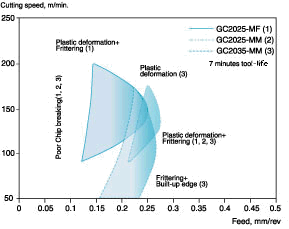 Figure 6. Cutting data recommendations for sandvik Sanmac 2205. GC 2025 and GC 2035 refer to Sandvik Coromant cemented-carbide insert grades.
Figure 6. Cutting data recommendations for sandvik Sanmac 2205. GC 2025 and GC 2035 refer to Sandvik Coromant cemented-carbide insert grades.
The machining ranges are limited by different wear mechanisms. Once the type of wear has been determined, the cutting data can be optimized with the aid of the diagram.
Microstructure
In the solution annealed and quenched condition Sanmac® 2205 has an austenitic-ferritic microstructure, which is free from grain-boundary carbides and intermetallic phases. The ferrite content is 35 – 55%.
Disclaimer: Recommendations are for guidance only, and the suitability of a material for a specific application can be confirmed only when we know the actual service conditions. Continuous development may necessitate changes in technical data without notice. This datasheet is only valid for Alleima materials.